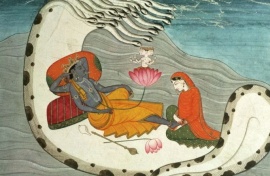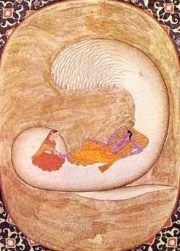Shesha
Da Ufopedia.
(→See also) |
(→External links) |
||
| (6 revisioni intermedie non mostrate.) | |||
| Riga 1: | Riga 1: | ||
| + | {{Tradurre}} | ||
[[File:Vishnu and Lakshmi on Shesha Naga, ca 1870.jpg|thumb|270px|[[Vishnu]] resting on Ananta-Shesha, with [[Lakshmi]] massaging his "lotus feet."]] | [[File:Vishnu and Lakshmi on Shesha Naga, ca 1870.jpg|thumb|270px|[[Vishnu]] resting on Ananta-Shesha, with [[Lakshmi]] massaging his "lotus feet."]] | ||
| - | In [[Hindu]] ([[Historical Vedic religion|Vedic]]) tradition, '''Shesha''' ( | + | In [[Hindu]] ([[Historical Vedic religion|Vedic]]) tradition, '''Shesha''' (Śeṣa in [[IAST]] transliteration, [[Devanagari]]: शेष) or '''Adi-shesha''' (Sheshanaag) is the king of all [[Nāga|nagas]], one of the primal beings of creation, and according to the [[Bhagavata Purana]], an [[avatar]] of the Supreme God<ref> [http://vedabase.net/sb/5/25/1/en1 Bhag-P 5.25.1] </ref> known as '''Sankarshan'''. In the [[Puranas]], Shesha is said to hold all the planets of the [[Universe]] on his hoods and to constantly sing the glories of [[Vishnu]] from all his mouths. He is sometimes referred to as "Ananta-Shesha" which means "Endless Shesha" and as "Adishesha", which means First snake. |
A ''[[dasa]]'' (servant) of Lord Vishnu, he is said to have incarnated in two of his [[Avatar]]s: [[Lakshmana]], brother of Lord [[Rama]], and [[Balarama]], brother of Lord [[Krishna]]. | A ''[[dasa]]'' (servant) of Lord Vishnu, he is said to have incarnated in two of his [[Avatar]]s: [[Lakshmana]], brother of Lord [[Rama]], and [[Balarama]], brother of Lord [[Krishna]]. | ||
| Riga 7: | Riga 8: | ||
[[Image:Shesh shaiya Vishnu.jpg|left|thumb|''Shesh shaiya'' of [[Vishnu]].]] | [[Image:Shesh shaiya Vishnu.jpg|left|thumb|''Shesh shaiya'' of [[Vishnu]].]] | ||
[[File:Ananta vishnu.jpg|right|thumb|Ananta vishnu]] | [[File:Ananta vishnu.jpg|right|thumb|Ananta vishnu]] | ||
| - | Shesha is generally depicted with a massive form that floats coiled in space, or on the universal ocean, to form the bed on which Vishnu lies. Sometimes he is shown as five-headed or seven-headed, but more commonly as a many hundred-headed [[serpent (symbolism)|serpent]], sometimes with each head wearing an ornate crown. | + | Shesha is generally depicted with a massive form that floats coiled in space, or on the universal ocean, to form the bed on which Vishnu lies. Sometimes he is shown as five-headed or seven-headed, but more commonly as a many hundred-headed [[serpent (symbolism)|serpent]], sometimes with each head wearing an ornate crown. |
| - | He is closely associated with Vishnu. His name means "that which remains", from the [[Sanskrit]] [[root (linguistics)|root]] '' | + | He is closely associated with Vishnu. His name means "that which remains", from the [[Sanskrit]] [[root (linguistics)|root]] ''śiṣ'', because when the world is destroyed at the end of the [[kalpa (time unit)|kalpa]], Shesha remains as he is. |
==Other details== | ==Other details== | ||
| - | [[Balarama]], [[Lakshmana]], and [[Nityananda|Nityananda Prabhu]], are considered avataras of Shesha (or vice versa). [[Patañjali]] is also considered an [[emanation]] or [[incarnation]] of Shesha and is iconographically depicted in naga form with naga canopy. | + | [[Balarama]], [[Lakshmana]], and [[Nityananda|Nityananda Prabhu]], are considered avataras of Shesha (or vice versa). [[Patañjali]] is also considered an [[emanation]] or [[incarnation]] of Shesha and is iconographically depicted in naga form with naga canopy. |
| - | + | In a story from the [[Purana]]s, Shesha loosens [[Mount Mandara]], to enable it to be used in the churning of the ocean by the [[deva (Hinduism)|deva]]s and [[asura]]s. | |
| - | In a story from the [[Purana]]s, Shesha loosens [[Mount Mandara]], to enable it to be used in the churning of the ocean by the [[deva (Hinduism)|deva]]s and [[asura]]s. | + | According to the [[Mahabharata]] (Adi Parva), his father was [[Kashyapa]] and his mother [[Kadru]]. |
| - | + | The city of [[Thiruvananthapuram]] is named after him as the "City of Lord Ananta". | |
| - | According to the [[Mahabharata]] (Adi Parva), his father was [[Kashyapa]] and his mother [[Kadru]]. | + | |
| - | + | ||
| - | The city of [[Thiruvananthapuram]] is named after him as the "City of Lord Ananta". | + | |
==Quotations== | ==Quotations== | ||
| Riga 42: | Riga 40: | ||
*Ananta (endless/infinite). | *Ananta (endless/infinite). | ||
*Nagashayana | *Nagashayana | ||
| - | *Alternative spelling: Sesa, Sesha, | + | *Alternative spelling: Sesa, Sesha, Śeṣa. |
==See also== | ==See also== | ||
| Riga 65: | Riga 63: | ||
[[Categoria:Spiritualità/Religioni]] | [[Categoria:Spiritualità/Religioni]] | ||
| + | [[categoria:Rettiliani]] | ||
Versione attuale delle 12:46, 9 ott 2013
| Questa voce ha bisogno di essere tradotta. |
In Hindu (Vedic) tradition, Shesha (Śeṣa in IAST transliteration, Devanagari: शेष) or Adi-shesha (Sheshanaag) is the king of all nagas, one of the primal beings of creation, and according to the Bhagavata Purana, an avatar of the Supreme God[1] known as Sankarshan. In the Puranas, Shesha is said to hold all the planets of the Universe on his hoods and to constantly sing the glories of Vishnu from all his mouths. He is sometimes referred to as "Ananta-Shesha" which means "Endless Shesha" and as "Adishesha", which means First snake.
A dasa (servant) of Lord Vishnu, he is said to have incarnated in two of his Avatars: Lakshmana, brother of Lord Rama, and Balarama, brother of Lord Krishna.
Indice |
Form
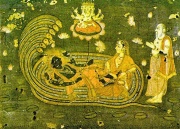
Shesha is generally depicted with a massive form that floats coiled in space, or on the universal ocean, to form the bed on which Vishnu lies. Sometimes he is shown as five-headed or seven-headed, but more commonly as a many hundred-headed serpent, sometimes with each head wearing an ornate crown.
He is closely associated with Vishnu. His name means "that which remains", from the Sanskrit root śiṣ, because when the world is destroyed at the end of the kalpa, Shesha remains as he is.
Other details
Balarama, Lakshmana, and Nityananda Prabhu, are considered avataras of Shesha (or vice versa). Patañjali is also considered an emanation or incarnation of Shesha and is iconographically depicted in naga form with naga canopy. In a story from the Puranas, Shesha loosens Mount Mandara, to enable it to be used in the churning of the ocean by the devas and asuras. According to the Mahabharata (Adi Parva), his father was Kashyapa and his mother Kadru. The city of Thiruvananthapuram is named after him as the "City of Lord Ananta".
Quotations
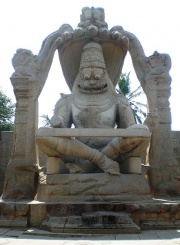
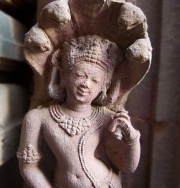
- "The foremost manifestation of Krishna is Sankarshana, who is known as Ananta. He is the origin of all incarnations within this material world. Previous to the appearance of Lord Krishna, this original Sankarshana will appear as Baladeva, just to please the Supreme Lord Krishna in His transcendental pastimes." (Bhagavata Purana 10.1.24)
- "That Ananta Sesha is the devotee incarnation of Godhead. He knows nothing but service to Lord Krishna." (Sri Chaitanya Caritamrita Adi-lila 5.120)
- "My dear King, approximately 240,000 miles beneath the planet Patala lives another incarnation of the Supreme Personality of Godhead. He is the expansion of Lord Vishnu known as Lord Ananta or Lord Sankarshana. He is always in the transcendental position, but because He is worshiped by Lord Siva, the deity of tamo-guna or darkness, He is sometimes called Tamasi. Lord Ananta is the predominating Deity of the material mode of ignorance as well as the false ego of all conditioned souls. When a conditioned living being thinks, 'I am the enjoyer, and this world is meant to be enjoyed by me,' this conception of life is dictated to him by Sankarshana. Thus the mundane conditioned soul thinks himself the Supreme Lord." (Bhagavata Purana 5.25.1)
- "Sri Anantadeva has thousands of faces and is fully independent. Always ready to serve the Supreme Personality of Godhead, He waits upon Him constantly. Sankarshana is the first expansion of Vasudeva, and because He appears by His own will, He is called svarat, fully independent. He is therefore infinite and transcendental to all limits of time and space. He Himself appears as the thousand-headed Sesha." (Srila Jiva Gosvami, in his Krishna-sandarbha)
- "Sankarshana of the quadruple form descends with Lord Rama as Lakshmana. When Lord Rama disappears, Sesha again separates Himself from the personality of Lakshmana. Sesha then returns to His own abode in the Patala regions, and Lakshmana returns to His abode in Vaikuntha." (A. C. Bhaktivedanta Swami Prabhupada)
- In the Bhagavad-Gita, when in the middle of the battlefied Kurukshetra, Krishna explaining his omnipresence, says: "Of Nāgas, I am Ananta" indicating the importance of Ananta Shesha. [2]
Other names
- Sheshanaga (Sesha the serpent)
- Adisesha (the first Sesha)
- Anantasesha (Endless Sesha)
- Ananta (endless/infinite).
- Nagashayana
- Alternative spelling: Sesa, Sesha, Śeṣa.
See also
- Avatars of Shesha
Footnotes
- ↑ Bhag-P 5.25.1
- ↑ Bhagavad Gita 10.29 "Of the many-hooded Nagas I am Ananta"
